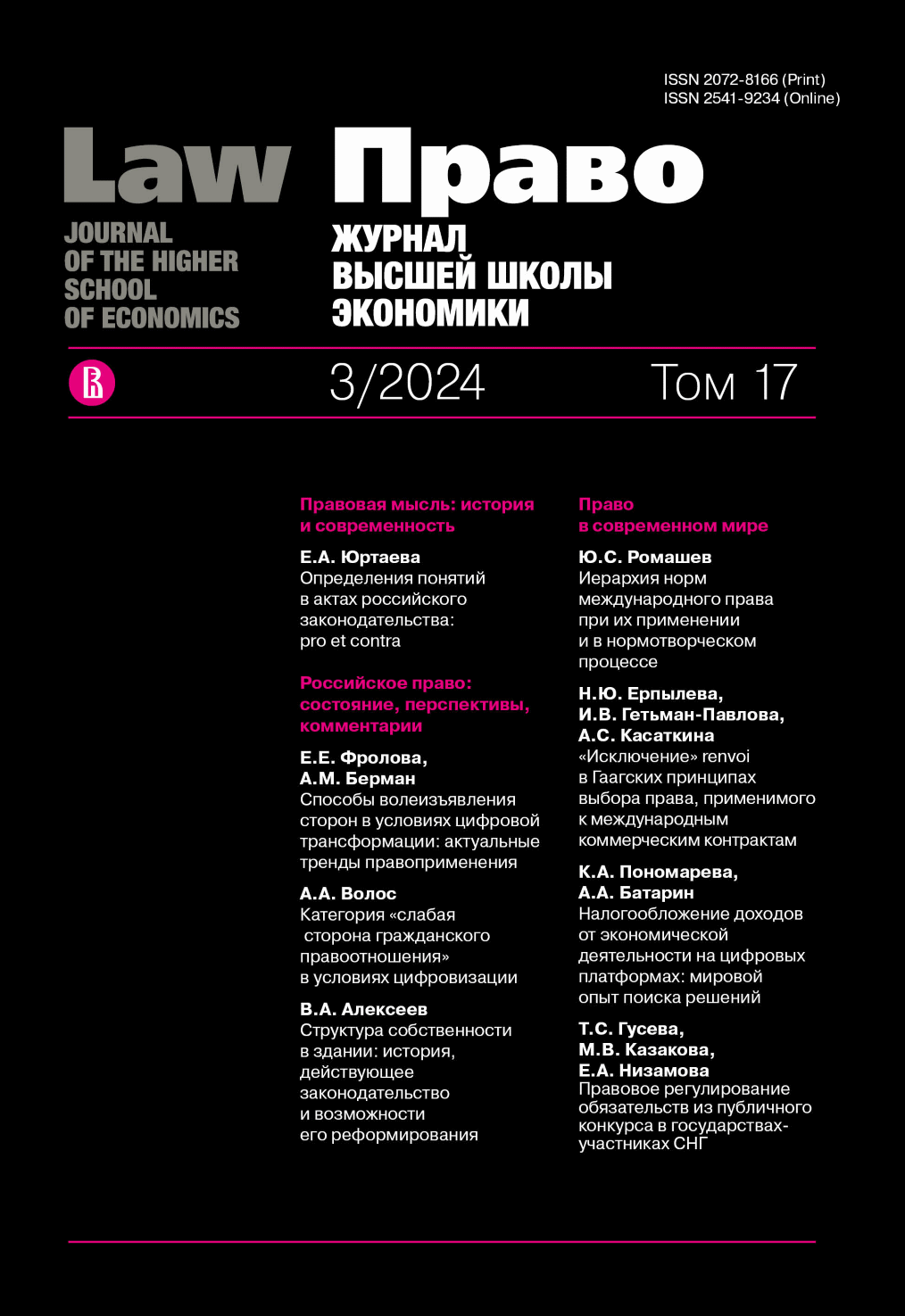Концепция мема (меметика) и первичные механизмы социокультурной эволюции права
Аннотация
Новые технологии и связанная с их распространением смена технологического уклада влияют на изменение ценностных ориентиров и установок личности, общества и нации, определяют динамику в их правовом поведении. Российская правовая культура оказывается перед лицом ранее неизвестных вызовов, обусловленных новой культурной доминантой высокотехнологичного общества, определяемой технологическим императивом. На смену утрачивающему актуальность и «умирающему» постмодернизму приходят диджимодернизм, автомодернизм и киберкультурализм, ведущие к сдвигу парадигмы культуры и ее переопределению. Актуализируются задачи сохранения сущностных характеристик культуры и модернизации базовых параметров на основе проектного прогнозирования, объединяющего проект и прогноз в единое целое. Целями исследования являются определение по аналогии с генетикой эволюционного алгоритма, стратегии, программирования трансформации правовой культуры и выявление первичных механизмов ее формирования, воспроизводства и развития в свете правовой меметики и кодирования релевантной информации в правовых мемах. Исследование базируется на юридическом прогнозировании и моделировании, постклассической методологии права, культуральном подходе, принципах конструктивизма и антропоцентризма. На основе обращения к новому междисциплинарному направлению — меметике, объясняющей культурную эволюцию посредством концепции мемов (условных единиц передачи культурного наследия), — анализируется значение правовой меметики и правовых мемов в механизме формирования и развития правовой культуры. Выявляются ключевые мемы правотворчества, факторы, способы и средства их вариаций и отбора, которые могут способствовать развитию или ограничению правовых норм и практик. Определяются модели управления мемами и их функционирования в рамках правовой системы. Резюмируется, что первичным механизмом воспроизводства мемов в праве является правотворчество, а правовая меметика позволяет исследовать динамику изменений правовой культуры и культуры правотворчества в контексте формирования и изменения правовых систем, решать задачи сохранения стабильности правовых регуляторов и придания им необходимой адаптивности, определять национально-правовую идентичность.
Литература
Baranova M.V. (2020) Law-cultural memes in a program communications society. In: Law and statute in the programmed society (100th jubilee of Daniel Bell): collection of papers. V.V. Lazarev (ed.). Moscow: Norma, pp. 126–132 (in Russ.)
Bekhterev V.M. (1999) Selected works on personality psychology. Vol. 2: Objective study of personality. Saint Petersburg: Aleteya, 281 p. (in Russ.)
Blackmore S. (1999) The meme machine. Oxford: University Press, 258 p.
Brodie R. (2007) Virus of the mind. How your mind is programmed. Moscow: Pokolenie, 304 p. (in Russ.)
Chestnov I.L., Tonkov E.N. (eds.) (2018) Cultural studies of law. Saint Petersburg: Aleteya, 466 p. (in Russ.)
Claidière N., André J.-B. (2012) The transmission of genes and culture: a questionable analogy. Evolutionary Biology, vol. 39, pp. 12–24. DOI: https://doi.org/10.1007/s11692-011-9141-8
Cotterrell R. (2006). Law, culture and society: legal ideas in the mirror of social theory. Aldershott: Ashgate Publishing, 208 p.
Dawkins R. (2013) The selfish gene. Moscow: AST, 245 p. (in Russ.)
Deakin S. (2002) Evolution for our time: a theory of legal memetics. Current Legal Problems, vol. 55, no. 1, pp. 1–42. DOI: https://doi.org/10.1093/clp/55.1.1
Dennet D.C. (1991) Consciousness explained. New York: Little, Brown and Company, 511 p.
Ehrlich E. (2011) The foundation of the sociology of law. Saint Petersburg: University, 704 p. (in Russ.)
Ghasemi M. (2024) Paradigms of cyberculturalism in post-postmodernity. In: T. Tsimpouki et al. (eds.) American studies after postmodernism. Renewing the American narrative. Cham: Palgrave Macmillan, pp. 309–328. DOI: https://doi.org/10.1007/978-3-031-41448-0_16
Gavrilova Yu. A. (2011) The semantic field of law (philosophical and legal aspect). Volgograd: University, 154 p. (in Russ.)
Henke C. (2007) Memetik und recht. Humboldt Forum Recht, no. 2, S. 13–26.
Heylighen F. (1997) Objective, subjective and intersubjective selectors of knowledge. Evolution and Cognition, no. 3, pp. 63–67.
Kartashov V.N. (2019) Legal culture, anti-culture and responsibility in the legal system of society. Moscow: Prospekt, 352 p. (in Russ.) DOI: https://doi.org/10.31085/9785392287758-2019-352
Kerimov D.A. (1991) Culture and technique of lawmaking. Moscow: Yuridicheskaya literatura, 160 p. (in Russ.)
Kirby A. (2009) Digimodernism. How new technologies dismantle the postmodern and reconfigure our culture. New York–London: Continuum, 290 p.
Komarov A.S. (2023) Reform of national civil law in the transitional period. In: Private international law: continuity and development. Papers of international conference. N.G. Doronina (ed.). Moscow: Kontrakt, pp. 33–42 (in Russ.)
Krepysheva S.K. (2019) Basics of forensic law enforcement culture. Vestnik Nizhegorodskogo Universiteta=Bulletin of Nizhni Novgorod University, no. 6, pp. 127–131 (in Russ.)
Lazarev V.V. (2020) State in the light of memology. Zhurnal rossiyskogo prava=Journal of Russian Law, no. 3, pp. 5–18 (in Russ.) DOI: https://doi.org/10.12737/jrl.2020.026
Lynch A. (1996) Thought contagion. How belief spreads through society. New York: Basic Books, 182 p.
Maltsev G.V. (2013) Cultural traditions of law. Moscow: Norma, 607 p. (in Russ.)
Malysheva E.V., Bynev A.A. (2016) Memetics: issues and perspectives. In: Linguistic discourse in social practice: papers of international conference. Tver: Tver State University, pp. 148–151 (in Russ.)
Maurer B. (2004) The cultural power of law? Conjunctive readings. Law & Society Review, vol. 38, no. 4, pp. 843–850. DOI: https://doi.org/10.1111/j.0023-9216.2004.00070.x
Milovanova M.V., Terentjeva E.V. (2022) Internet memes as a relevant phenomenon of political Internet communication in Russia. Gumanitarnye i socialnye nauki=The Humanities and Social Sciences, vol. 93, no. 4, pp. 58–66 (in Russ.)
Nelken D. (2016) Comparative legal research and legal culture: facts, approaches, and values. Annual Review of Law and Social Science, vol. 12, pp. 45–62. DOI: https://doi.org/10.1146/annurev-lawsocsci-110615-084950
Polyakov E.M. (2010) The memetika: science or the paradigm? Vestnik Voronezhskogo universiteta=Bulletin of Voronezh State University, no. 2, pp. 160–165 (in Russ.)
Romanov A.A. (2016) Mechanisms for disseminating of “viral” ideas in information space of regulatory and memetic reality. Mir lingvistiki i kommunikacii=World of Linguistics and Communication, no. 2, pp. 1–19 (in Russ.)
Rosen L. (2006) Law as culture: an invitation. Princeton: University Press, 232 p. DOI: https://doi.org/10.1515/9781400887583
Samuels R. (2009) Automodernity: autonomy and automation after postmodernity. In: New media, cultural studies, and critical theory after postmodernism. Education, psychoanalysis, and social transformation. New York: Palgrave Macmillan, pp. 3–25. DOI: https://doi.org/10.1057/9780230104181_1
Sazonnikova E.V. (2011) Cultural studies of constitutional lawmaking and law enforcement. Kultura: upravlenie, ekonomika, pravo=Culture: Management, Economy, Law, no. 4, pp. 7–8 (in Russ.)
Schlaile M.P. (ed.) (2021) Memetics and evolutionary economics: to boldly go where no meme has gone before. Cham: Springer International, 224 p. DOI: https://doi.org/10.1007/978-3-030-59955-3
Silbey S. (1992) Making a place for cultural analyses of law. Law & Social Inquiry, vol. 17, no. 1, pp. 39–48. DOI: https://doi.org/10.1086/492364
Sinyukov V.N. (2021) Law of the 20th and 21st centuries: continuity and innovations. Russkiy zakon=Lex Russica, no. 2, pp. 9–20 (in Russ.) DOI: https://doi.org/10.17803/1729-5920.2021.171.2.009-020
Sperber D. (2001) Conceptual tools for a natural science of society and culture. Proceedings of the British Academy, no. 111, pp. 297–317.
Stepin V.S. (2011) Civilization and culture. Saint Petersburg: University, 408 p. (in Russ.)
Syrykh V.M. (2023) Legal culture in society as objective basis for current legislation. Pravova kultura=Legal Culture, vol. 53, no. 2, pp. 30–40 (in Russ.)
Tosunyan G.A., Sannikova L.V. (2018) Culture of law-making in modern Russia. Gosudarstvo i pravo=State and Law, no. 3, pp. 28–34 (in Russ.)
Vilovatykh A.V. (2018) Memetics as an instrument for modern informational confrontation. Problemy natcionalnoi strategii=Issues of National Strategy, no. 5, pp. 141–154 (in Russ.)
Voloshin V.V. (2023) Meme and memetics: epistemological angle. Vestnik Tulskogo gosudarstvennogo universiteta=Bulletin of Tula State University, no. 1, pp. 224–237 (in Russ.)
Zinovieva N.A. (2016) Translation of socio-cultural codes in the creation of an information product: analysis of Internet memes. Candidate of Sociological Sciences Summary. Saint Petersburg, 26 p. (in Russ.)
Copyright (c) 2024 Залоило М.

Это произведение доступно по лицензии Creative Commons «Attribution-ShareAlike» («Атрибуция — На тех же условиях») 4.0 Всемирная.


















